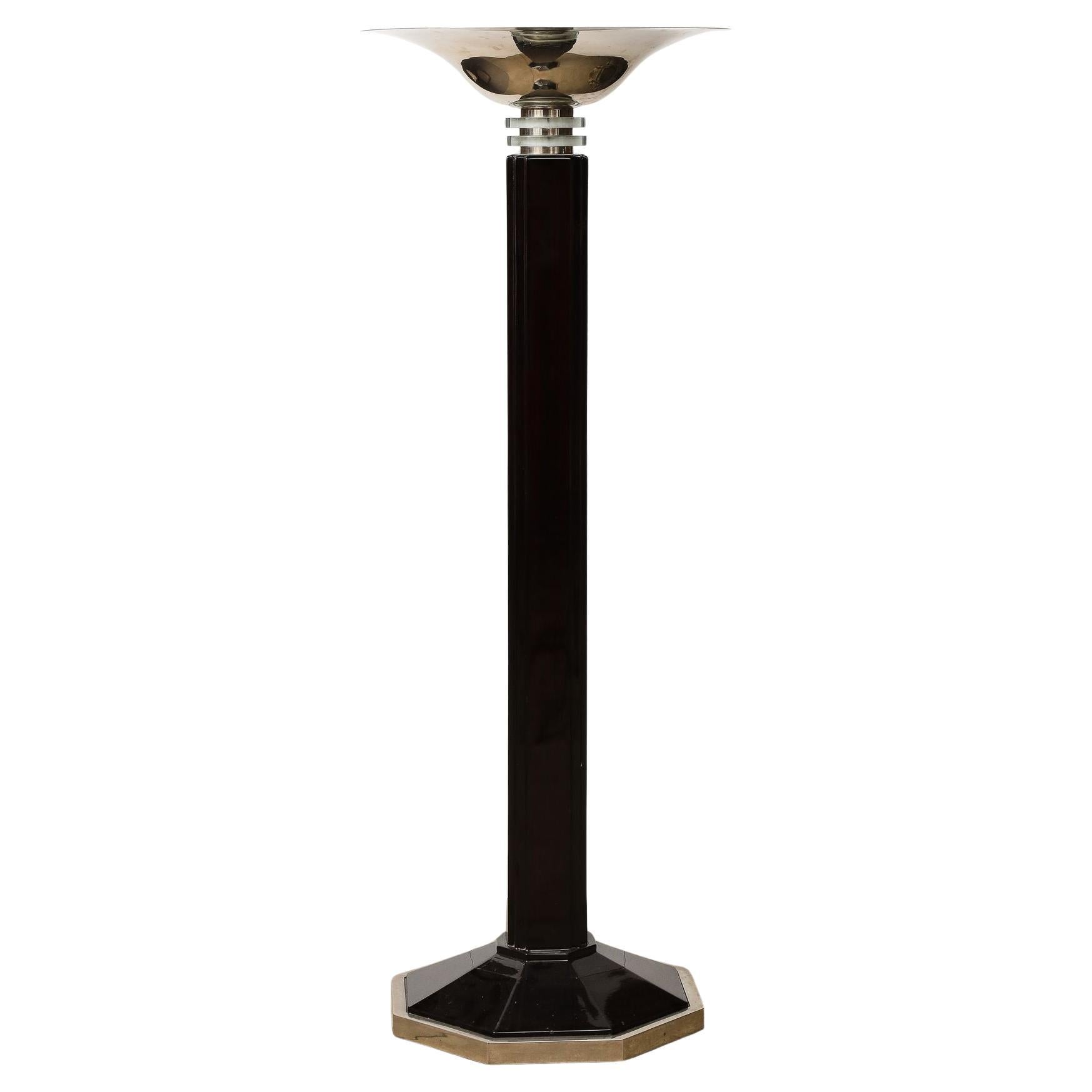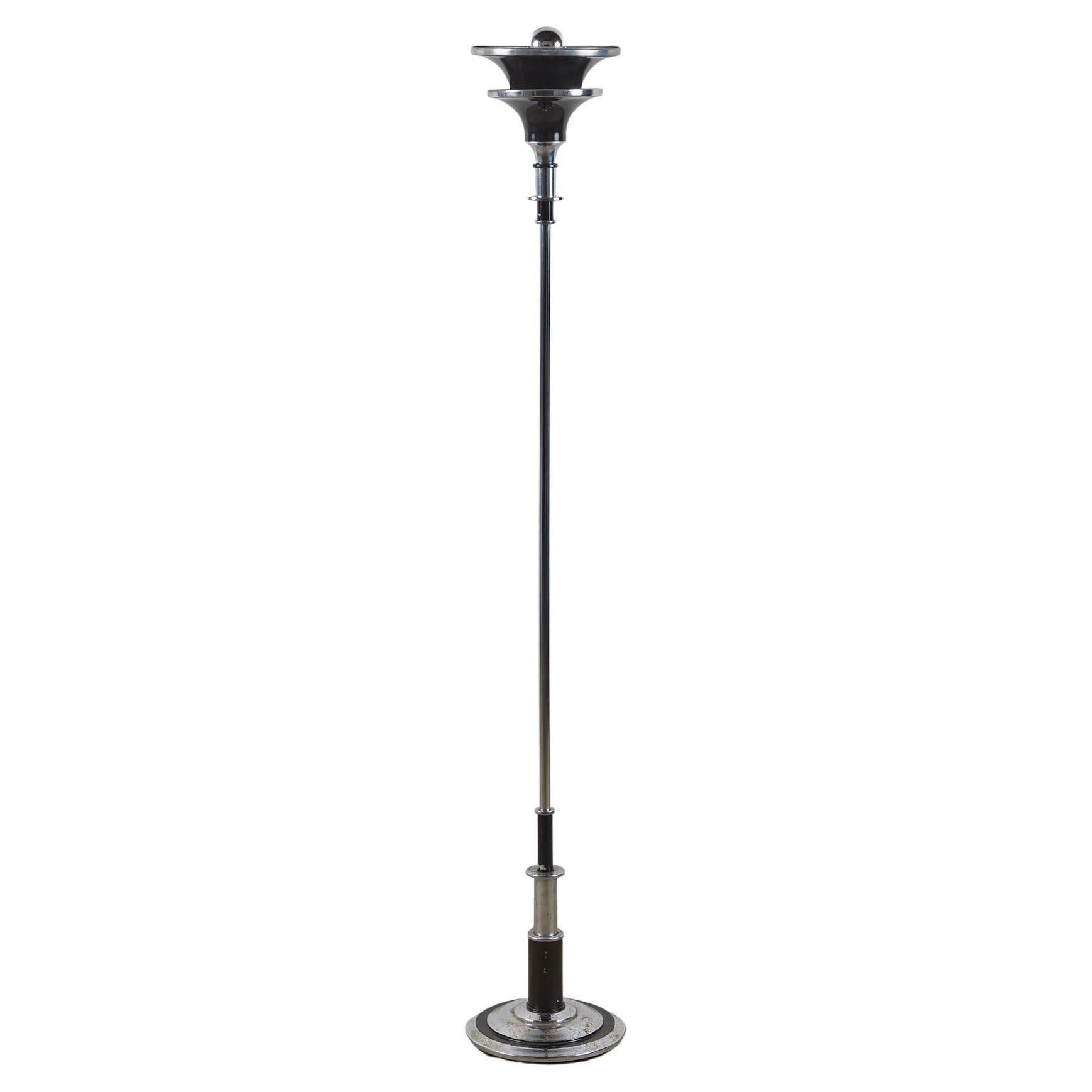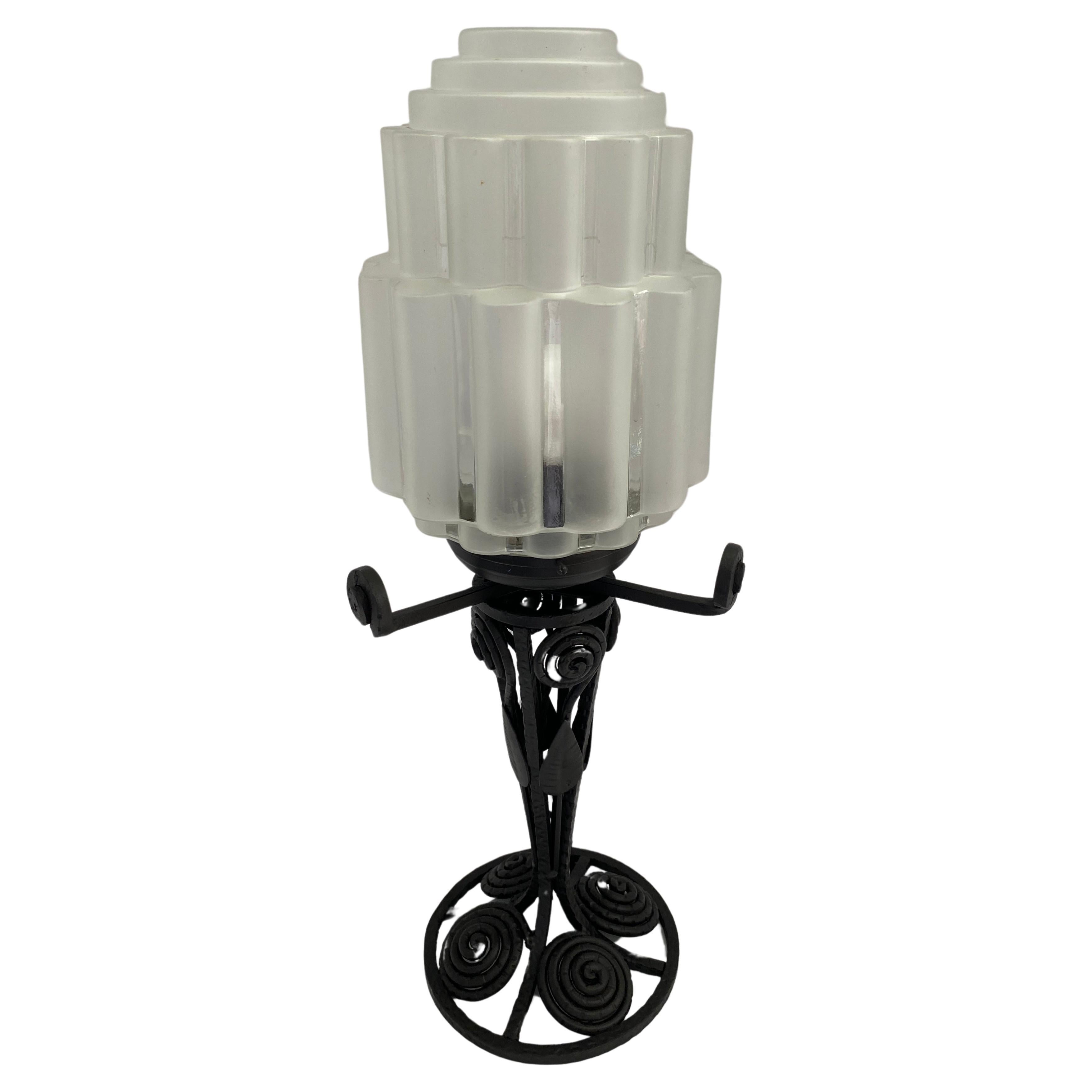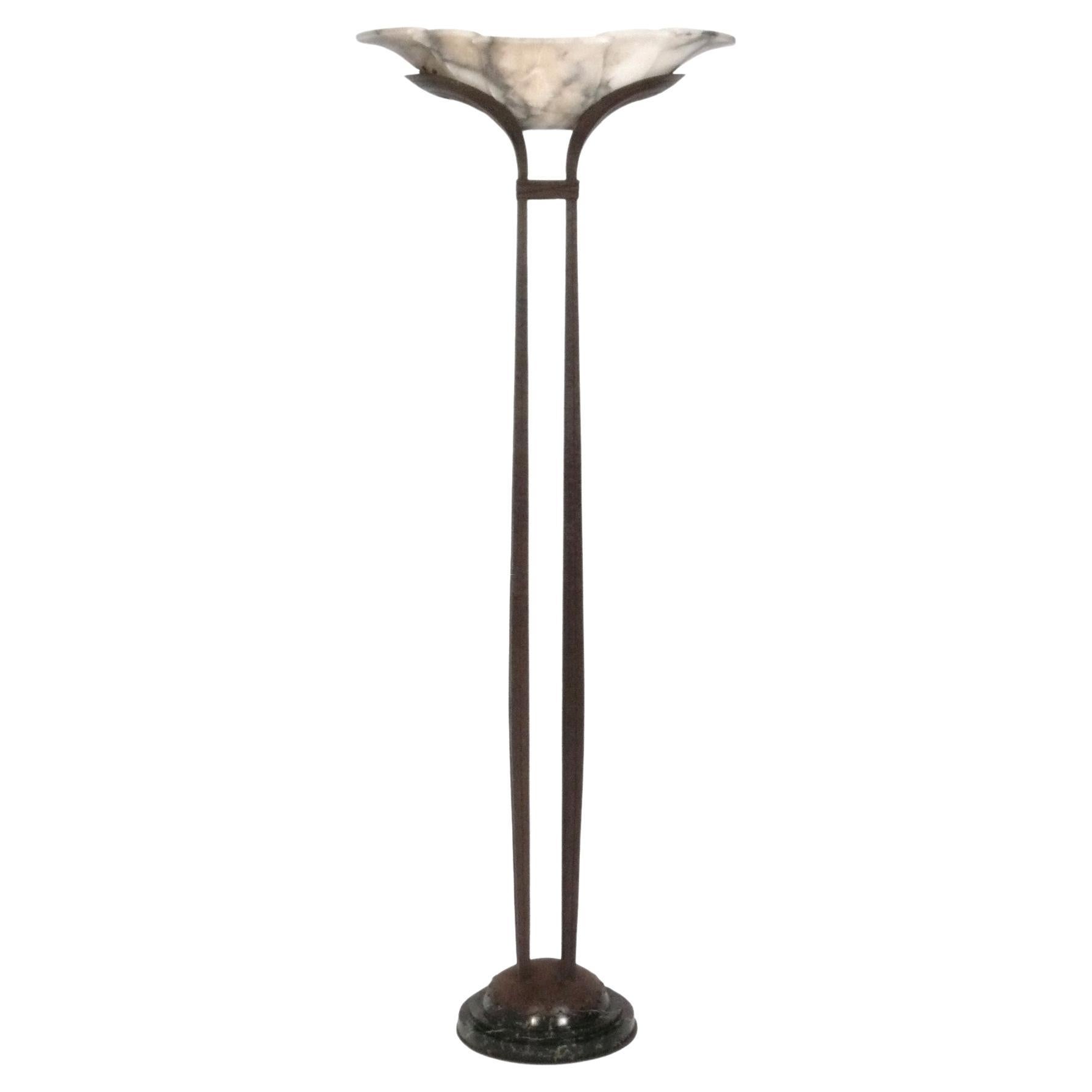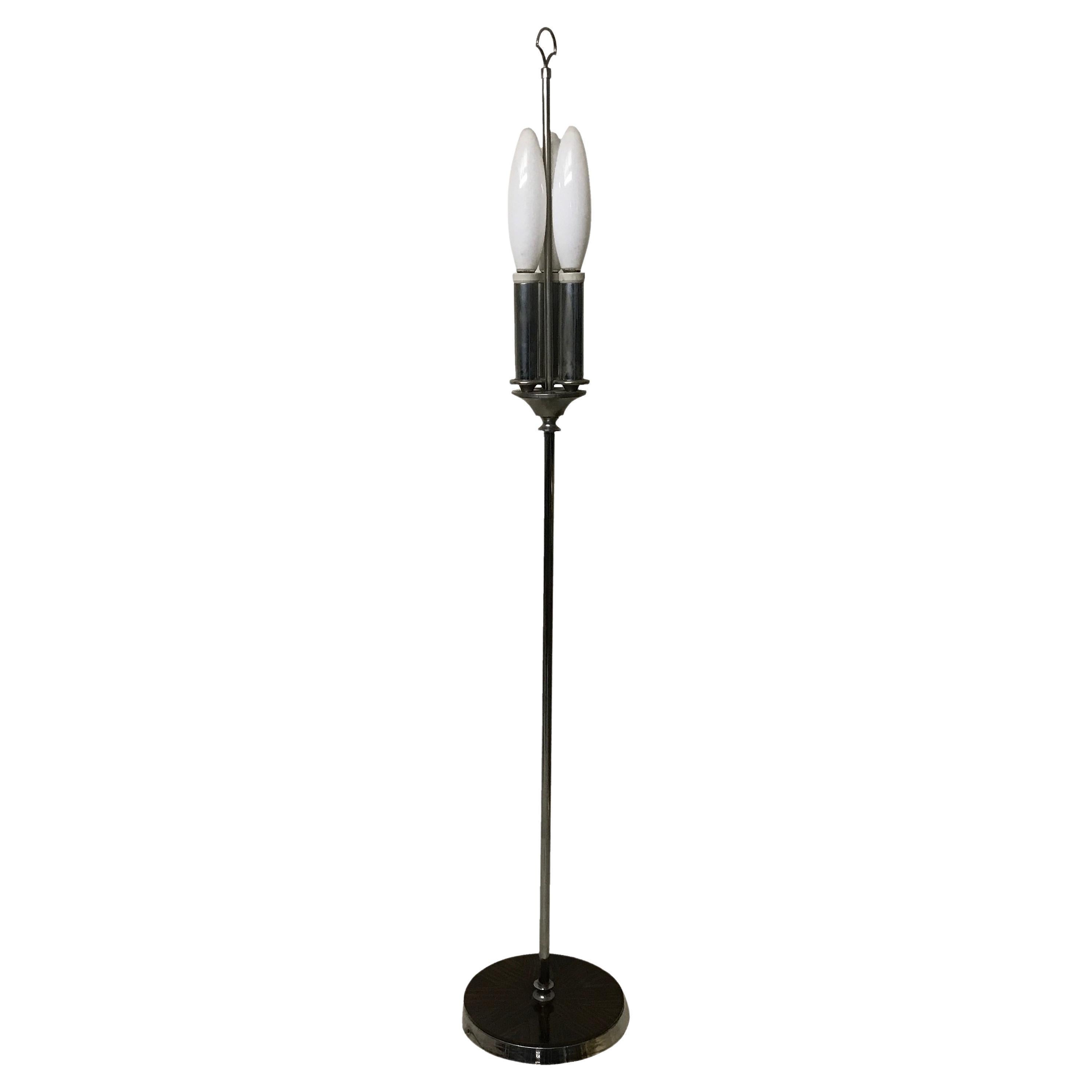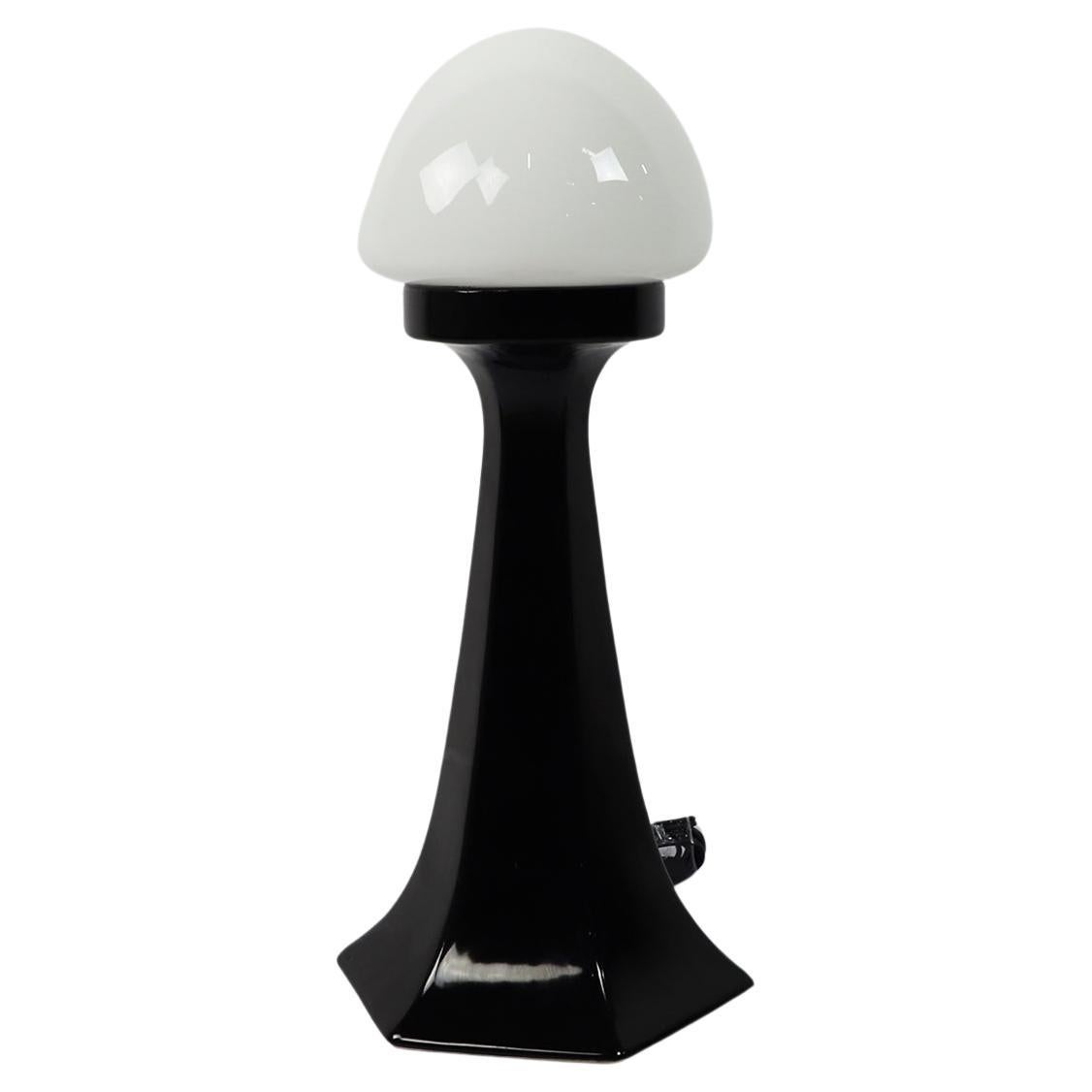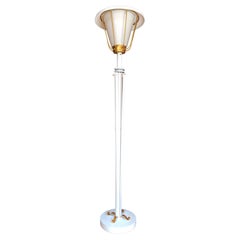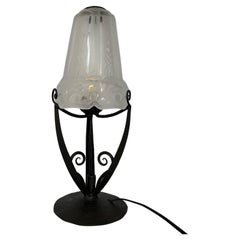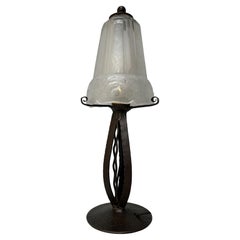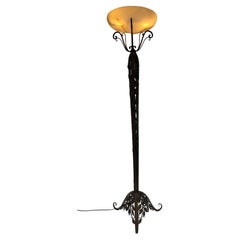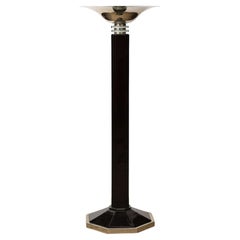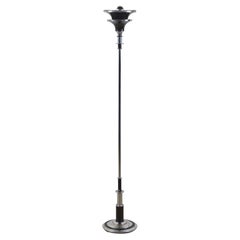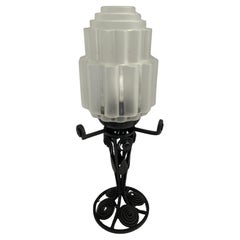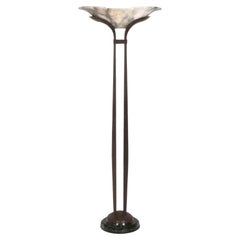Items Similar to Art Deco Degué Luminous Stand Diamond Model
Video Loading
Want more images or videos?
Request additional images or videos from the seller
1 of 14
Art Deco Degué Luminous Stand Diamond Model
$4,137.63
£3,115.22
€3,500
CA$5,710.55
A$6,397.08
CHF 3,327.27
MX$78,031.13
NOK 42,360.63
SEK 39,943.06
DKK 26,645.50
About the Item
Art deco wrought iron harness circa 1930.
Molded Degué glass ball "Diamond" model (unsigned).
Electrified and in perfect condition.
Total height: 140cm
Ball diameter: 30 cm
Weight: 19 Kg
The shipment is made in two packages: 1 for the harness and another for the glass ball.
DEGUE (David GUERON)
In 1926, David GUERON (1892-1950) took over a former glassworks-crystalworks in Compiègne (Oise), specializing in perfumery bottles which named: “SA Cristalleries de Compiègne”. In the same year, he founded the "Verserie d'Art Degué" at 63 boulevard Malherbes in Paris (factory) and acquired premises at 41 rue de Paradis in the 10th arrondissement (exhibition store), in order to present with a production of vases and lamps in bright colors and quality. The latter will be moved to 52, rue de Londres in Paris.
He is inspired by an Art Deco style of the decorations of Charles Schneider which will want him in legal proceedings for counterfeiting with success by Schneider in 1932. Edouard Cazeaux is the artistic director of David Guéron.
The crystal factory also produced glasses and industrial goblets between 1934 and 1935. It placed an order for 6,000 pieces for the liner “Le Normandie” intended for wall and light decoration made up of chisel-cut glass slabs.
It was the Second World War that put an end to the Verrerie d'Art Degué, David Guéron leaving France in 1939 to escape the Nazis.
- Creator:Degué (Designer)
- Dimensions:Height: 55.12 in (140 cm)Diameter: 11.82 in (30 cm)
- Power Source:Plug-in
- Voltage:110-150v,220-240v
- Lampshade:Included
- Style:Art Deco (Of the Period)
- Materials and Techniques:
- Place of Origin:
- Period:
- Date of Manufacture:1930
- Condition:
- Seller Location:NANTES, FR
- Reference Number:1stDibs: LU7403235885532
About the Seller
No Reviews Yet
Vetted Professional Seller
Every seller passes strict standards for authenticity and reliability
1stDibs seller since 2022
47 sales on 1stDibs
Typical response time: 7 hours
- ShippingRetrieving quote...Shipping from: NANTES, France
- Return Policy
Authenticity Guarantee
In the unlikely event there’s an issue with an item’s authenticity, contact us within 1 year for a full refund. DetailsMoney-Back Guarantee
If your item is not as described, is damaged in transit, or does not arrive, contact us within 7 days for a full refund. Details24-Hour Cancellation
You have a 24-hour grace period in which to reconsider your purchase, with no questions asked.Vetted Professional Sellers
Our world-class sellers must adhere to strict standards for service and quality, maintaining the integrity of our listings.Price-Match Guarantee
If you find that a seller listed the same item for a lower price elsewhere, we’ll match it.Trusted Global Delivery
Our best-in-class carrier network provides specialized shipping options worldwide, including custom delivery.More From This Seller
View All1940 Floor Lamp Indoor Outdoor
Located in NANTES, FR
Floor lamp in white and gold lacquered wrought iron.
Electrified and in very good condition.
Shipped in two separate packages.
Total height: 200 cm
Base diameter: 35 cm
Top diamet...
Category
Vintage 1940s French Art Deco Floor Lamps
Materials
Wrought Iron
Art Deco Lamp By Maynadier
Located in NANTES, FR
Art deco lamp circa 1930.
Wrought iron base and molded glass tulip with geometric and floral decoration.
Electrified and in perfect condition.
Signed Maynadier on the tulip.
Diamete...
Category
Vintage 1930s French Art Deco Table Lamps
Materials
Wrought Iron
Art Deco Lamp Signed Maynadier
Located in NANTES, FR
Art Deco lamp circa 1930.
Wrought iron base and pressed molded tulip with floral decoration.
In perfect condition and electrified.
Total height: 34 cm
Base diameter: 10.5 cm
Weight:...
Category
Mid-20th Century French Art Deco Table Lamps
Materials
Wrought Iron
Art Deco Floor Lamp in Wrought Iron and Alabaster
Located in NANTES, FR
Art Deco wrought iron floor lamp circa 1930.
Wrought iron base with foliage decoration.
Alabaster bowl.
Lamppost in perfect condition and electrified.
Total height: 168 cm
Diameter ...
Category
Mid-20th Century French Art Deco Floor Lamps
Materials
Alabaster, Wrought Iron
Edgar Brandt Rare Art Deco Floor Lamp
By Edgar Brandt
Located in NANTES, FR
Edgar Brandt rare Art Deco floor lamp.
Nickel-plated wrought iron floor lamp stamped E.Brandt, alabaster basin.
In very good condition.
Electr...
Category
Mid-20th Century French Art Deco Floor Lamps
Materials
Alabaster, Wrought Iron
Art Deco floor lamp by Jules Cayette and Schneider
By Jules Cayette, Charles Schneider
Located in NANTES, FR
Art Deco floor lamp circa 1925.
Wrought iron base by Jules Cayette.
Glassware by Charles Schneider.
1 basin of 40 cm in diameter and 6 blown glass balls.
In perfect condition, electrified, 3 lights.
Height: 167.5 cm
Base diameter: 49 cm
Basin diameter: 40 cm
Weight: 16 Kg
Édouard Élie Jules Cayette, born on May 27, 1882 in Paris and died on January 2, 1953 in Nancy, was a French ironworker, bronze worker, cabinetmaker, sculptor and interior decorator, representative of the Art Nouveau movement, then of that of Art Deco.
In 1896, he enrolled for the first time at the municipal and regional school of fine arts in Nancy. He left the school in 1899 and entered as an apprentice with Férez, a wood sculptor and carpenter from Nancy.
In 1900, he re-enrolled at the Beaux-Arts in Nancy, while continuing his apprenticeship with Schwartz. He left the school for good in 1902. During this apprenticeship, he received instruction from Victor Prouvé and Eugène Vallin. His classmates were Auguste Vallin, Joseph Mougin and Pierre Mougin.
In 1904, he joined Jacques Gruber as a collaborator, where he perfected his style. He modeled many compositions and made sculptures in place of the master as far as furniture was concerned. The workshop then adjoined that of Vallin, hence the latter's definite influence on Cayette's early works.
In 1910, Jules Cayette set up his own business and officially began his activity on August 1st. From 1912, he exhibited regularly at the Société lorraine des amis des arts. It was at this time that he met his main patron, Saint-Just Péquart (1881-1944).
He set up his first workshop on rue Collinet de La Salle in Nancy in 1913, the date of his first mention in the Meurthe-et-Moselle commercial directory. He married Marie Lucie Berche (1893-1933) on May 11, 1918. In 1919, he moved and set up his workshop at 63, rue des Jardiniers (which would be supplemented by the one on rue du Montet, currently avenue du Général Leclerc, bought from the widow Guth).
The 1920s were the glory years of the workshops, which employed a dozen workers. The productions were very varied: from bronze ashtrays to light fixtures — always with Daum glassware...
Category
Vintage 1920s French Art Deco Floor Lamps
Materials
Wrought Iron
You May Also Like
Joseph Urban Art Deco Floor Lamp.
By Joseph Urban
Located in New York, NY
This is a striking Art Deco style floor lamp designed by Joseph Urban, a prominent Austrian-American architect, illustrator, and set designer (1872-1933). Urban's designs often pushe...
Category
Vintage 1930s Art Deco Floor Lamps
Materials
Chrome
Art Deco Torchiere Floor Lamp
Located in Los Angeles, CA
Art Deco mixed metal floor lamp. This lamp features a spun aluminum top shade and a chrome plated stem and base. The lamp has alternating chrome and black enameled details.
Dimensio...
Category
Mid-20th Century American Art Deco Floor Lamps
Materials
Metal, Chrome, Aluminum
French Art Deco Table Lamp, Iron and Glass Art Deco Lamp
Located in Miami, FL
This captivating French Art Deco Table Lamp or Iron and Glass Art Deco Lamp table, circa 1925, showcases the timeless elegance of French Art Deco d...
Category
Early 20th Century French Art Deco Table Lamps
Materials
Iron
Art Deco Style Marble and Iron Floor Lamp
By Edgar Brandt
Located in Atlanta, GA
Art Deco style marble and iron floor lamp, in the manner of Edgar Brandt, French, probably circa 1980s, but possibly circa 1930s. It has been rewired for US usage.
Category
Vintage 1980s French Art Deco Floor Lamps
Materials
Marble, Metal, Iron
Floor Lamp Art Deco 1930, France, Materials, Chrome and Wood
Located in Ciudad Autónoma Buenos Aires, C
Floor lamp Art Deco
Materials: chrome and wood
France
1930
You want to live in the golden years, those are the floor lamps that your project needs.
We have specialized in the sale of Art Deco and Art Nouveau styles since 1982.
Pushing the button that reads 'View All From Seller'. And you can see more objects to the style for sale.
Why are there so many antiques in Argentina.
In the 1880 – 1940 there was a grate wave of immigration encouraged by the periods of war that were taking place.
1st World War took place between 1914 and 1918
2nd World War took place between 1939 and 1945
The immigrants options were New York or Buenos Aires. Tickets were cheap and in Buenos Aires they were welcomed with open arms, as it was a country where everything was still to be done.
Argentina was the country of new opportunities, labour was needed and religious freedom was assured, in many cases the of the family travel first until they were settled and then the rest of the family members join them.
In the immigrant museum “Ellis Island Immigrant Building” in New York you can se the promotional posters of the boats that would take them to a new life.
Between the years 1895 and 1896, Argentina had the highest DGP (gross domestic product) per capita in the world according to the Maddison Historical Statistics index, this situation arose due to the large amount of food being exported to European countries, which were at war.
The Argentinean ships left the port of Buenos Aires with food, but they returned with furniture, clothes and construction elements, (it´s common to see this the old buildings of the historic neighbourhood of San Telmo, the beams with the inscription “Made in England)”, as well as many markets that were built in Buenos Aires, such us the San Telmo Market, whose structure was brought by ship and afterwards assembled in 900 Defensa Street.
With the great influence of European immigrants living in the country, the children of the upper classes travelled to study in France, resulting in the inauguration of “La Maison Argentinienne”, on 27th of June 1928, in the international city of Paris, which hosted many Argentinians that were studying in Frace.
It´s the fourth house to be built after France, Canada and Belgium, being the first Spanish-speaking one. Still in place today (17 Bd Jourdan, 75014, Paris, France). Many of the children of these wealthy families who attended international art exhibitions, museums and art courses abroad, took a keen interest in the European style. This is why Buenos Aires was at the time referred as “The Paris of South America”.
Between the years 1890 and 1920 more than a hundred Palaces were built on Alvear Avenue the most exclusive avenue in Buenos Aires. Today some of these palaces have been transformed into museums, hotels and embassies.
In the year 1936, the Kavanagh building was inaugurated, it was the tallest reinforced concrete building in South America.
During 1994 the American Society of Civil Engineers distinguished it as an “international engineering milestone”, and it´s now considered a World Heritage of Modern Architecture.
At the time was common to hire foreign architects such as Le Corbusier, who visited Buenos Aires/Argentina in 1929 and in 1948 he drew up the blueprints for a house built in La Plata City (which was declared a World Heritage Site).
In 1947, the Hungarian architect Marcelo Breuer designed “Parador Ariston” in the seaside city of Mar del Plata. After an Argentinean student at Harvard University convinced him to come to Argentina. He worked on an urban development project in the Casa Amarilla, area of La Boca.
The Ukrainian architect, Vladimiro Acosta, arrives in Argentina in 1928 and worked as an architect until que moved to Brazil.
Antonio Bonet, a Spanish architect who worked with Le Corbusier in Paris, arrives in Argentina in 1937, where he carried out several architectural works and in 1938 designs the well-known BFK chair...
Category
Vintage 1930s French Art Deco Floor Lamps
Materials
Chrome
Art Deco Table Lamp Made in Ceramic, circa 1940s
Located in Mexico City, CDMX
Circa 1940. We offer this fantastic Art Deco table lamp made in ceramic and glass.
Category
Vintage 1940s Mexican Art Deco Floor Lamps
Materials
Ceramic, Glass
More Ways To Browse
Vintage Lighting Stand
Art Deco Industrial Light
Charles Of Paris Lamps
Degue Art Glass
Art Glass Floor Vase
Art Deco Ball Lamp
French Floor Vase
Black Goblets
Crystal 1930 Lamps
Vintage Glass Bottle Lamps
Crystal Ball Lamp
Cut Crystal Goblets
Diamond Cut Crystal Vase
Vintage Ball Bottle
Glass Art Deco Goblets
Art Deco Floor Vase
Diamond Cut Crystal Lamp
Mid Century Slab Vase
